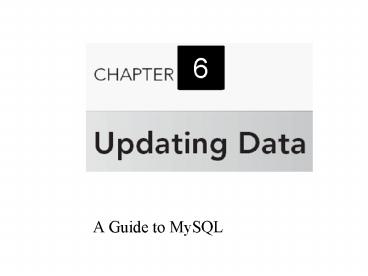A Guide to MySQL - PowerPoint PPT Presentation
1 / 33
Title:
A Guide to MySQL
Description:
Changing a Table's Structure. ALTER TABLE command allows for changing a table's structure ... COMMIT and ROLLBACK (continued) ROLLBACK command only reverses ... – PowerPoint PPT presentation
Number of Views:38
Avg rating:3.0/5.0
Title: A Guide to MySQL
1
6
- A Guide to MySQL
2
Objectives
- Create a new table from an existing table
- Change data using the UPDATE command
- Add new data using the INSERT command
- Delete data using the DELETE command
3
Objectives (continued)
- Use nulls in UPDATE commands
- Change the structure of an existing table
- Use the COMMIT and ROLLBACK commands to make
permanent data updates or to reverse updates - Understand transactions and the role of COMMIT
and ROLLBACK in supporting transactions - Drop a table
4
Creating a New Table from an Existing Table
- Can create new table from existing table
- Use CREATE TABLE command
- Create SELECT command to select desired data
- Can add query results to table by placing SELECT
command in an INSERT command
5
Creating a New Table from an Existing Table
(continued)
6
Creating a New Table from an Existing Table
(continued)
7
Changing Existing Data in a Table
- Use UPDATE command to change rows for which a
specific condition is true simple or compound
condition - Command format
- UPDATE (name of table to be updated)
- SET (name of the column to be updated new
value) can include a calculation
8
Changing Existing Data in a Table (continued)
9
Adding New Rows to an Existing Table
- Use the INSERT command to add additional data to
a table - Use SELECT to verify rows were added correctly
10
Adding New Rows to an Existing Table (continued)
11
Delete Existing Rows from a Table
- Use DELETE command to delete data from database
- Command format
- DELETE (table from which the row(s) is to be
deleted) - WHERE clause (with a condition to select the
row(s) to delete) - All rows satisfying the condition will be deleted
- If no condition then all rows deleted
12
Delete Existing Rows from a Table (continued)
13
Changing a Value in a Column to Null
- Command for changing value to null is same as
changing any other value - Affected column must be able to accept nulls
- Use the value NULL as the replacement value
14
Changing a Value in a Column to Null (continued)
15
Changing a Tables Structure
- MySQL allows changes to table structure
- Add new tables
- Delete tables no longer required
- Add new columns to a table
- Change physical characteristics of existing
columns
16
Changing a Tables Structure
- ALTER TABLE command allows for changing a tables
structure - Use ADD clause to add a new column ADD clause is
followed by the name of column to be added,
followed by its characteristics
17
Changing a Tables Structure (continued)
- Assign value to new column simplest approach is
to assign NULL as the value - Or use an UPDATE command
- Change all rows to most common value
- Change individual rows
18
Changing a Tables Structure (continued)
19
Changing a Tables Structure (continued)
20
Changing a Tables Structure (continued)
21
Changing a Tables Structure (continued)
22
Changing a Tables Structure (continued)
- MODIFY clause of ALTER TABLE command changes
characteristics of existing columns - Can use to change a column that currently rejects
null values use NULL in place of NOT NULL - Can increase and decrease size of column
23
Changing a Tables Structure (continued)
24
Making Complex Changes
- Changes to table structure may be beyond the
capabilities of MySQL - Eliminate multiple columns
- Change column order
- Combine data from two tables to one
- Create a new table
25
COMMIT and ROLLBACK
- Updates to a table are only temporary can cancel
during current work session - COMMIT command saves changes immediately during
current session - ROLLBACK command reverses the changes made since
last COMMIT command or in current work session
26
COMMIT and ROLLBACK (continued)
- ROLLBACK command only reverses changes made to
data - COMMIT command is permanent running ROLLBACK
after COMMIT cannot reverse the update - In MySQL must change value for AUTOCOMMIT
- SET AUTOCOMMIT 0
27
COMMIT and ROLLBACK (continued)
28
COMMIT and ROLLBACK (continued)
29
Transactions
- A transaction is a logical unit of work
- Sequence of steps that accomplish a single task
- Essential that the entire sequence be completed
successfully - COMMIT and ROLLBACK commands support transactions
30
Transactions (continued)
- Before starting updates for a transaction, COMMIT
any previous updates - Complete the updates for the transaction if it
cannot be completed, use ROLLBACK - If all updates complete, use COMMIT again
31
Dropping a Table
- Use DROP TABLE command to delete a table
- Permanently removes table and all its data from
database
32
Summary
- Use CREATE TABLE command to make a new table from
an existing table - Use UPDATE command to change data
- Use INSERT command adds new rows
- Use DELETE command to delete existing rows from a
table - Use SET clause
- To make values NULL
- Change specific value to null with a condition
33
Summary (continued)
- Use ALTER TABLE command with ADD clause to add a
column to a table - Use ALTER TABLE command with MODIFY clause to
change column characteristics - Use COMMIT command to make changes permanent
- Use ROLLBACK command to reverse updates
- Use DROP TABLE command to delete a table and its
data

